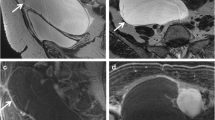Abstract
Objective
The purpose of this study is to investigate radiologic findings of struma ovarii, and to correlate both CT and MR findings.
Materials and methods
MR images of 26 cases were retrospectively reviewed. Post-contrast enhanced T1-weighted images were available in 17 patients. CT images, including seven non-contrast and eleven post-contrast studies, were available for review in 13 cases.
Results
All 26 tumors appeared as well-defined cystic tumors with solid components, which were multilobulated surfaces in 19 and smooth surfaces in seven. Twenty-four was multicystic, whereas two were unilocular. The solid components were recognized as thickened septi or walls in 23 and a mass in three tumors. On T2-weighted images, loculi of prominent low intensity were recognized in 16 tumors. On T1-weighted images, the punctuate foci of high intensity were recognized in 24 tumors in or adjacent to the solid components. Ascites was present in only one lesion. In six of seven cases with non-contrast CT images, high attenuation areas were recognized. In five of these six tumors, high attenuation areas corresponded to the areas of prominent low intensity and the solid components on T2-weighted images. In seven cases with CT, curvilinear calcifications were recognized in the solid components.
Conclusion
Struma ovarii typically presents as a lobulated multicystic lesion with solid components. The tumors frequently include loculi of low intensity on T2-weighted images and punctuate foci of high intensity on T1-weighted images. On CT, high attenuation areas and calcifications in the solid components are common findings.






Similar content being viewed by others
References
Kurman RJ (2002) Germ cell tumors of the ovary. Blaustein’s pathology of the female genital tract, 5th edn. New York: Springer
Scully RE, Young RH, Clement PB (1998) Monodermal teratomas. Tumors of the ovary, maldeveloped gonads, fallopian tube, and broad ligament. Atlas of tumor pathology. Third Series, Fascicle 23. Armed Forces Institute of Pathology, Washington DC
Outwater EK, Siegelman ES, Hunt JL (2001) Ovarian teratomas: tumor types and imaging characteristics. Radiographics 21(2):475–490
Joja I, Asakawa T, Mitsumori A, et al. (1998) Struma ovarii: appearance on MR images. Abdom Imaging 23(6):652–656
Kempers RD, Dockerty MB, Hoffman DL, Bartholomew LG (1970) Struma ovarii—ascitic, hyperthyroid, and asymptomatic syndromes. Ann Intern Med 72(6):883–893
Kim JC, Kim SS, Park JY (2000) MR findings of struma ovarii. Clin Imaging 24(1):28–33
Matsuki M, Kaji Y, Matsuo M, Kobashi Y (2000) Struma ovarii: MRI findings. Br J Radiol 73(865):87–90
Dohke M, Watanabe Y, Takahashi A, et al. (1997) Struma ovarii: MR findings. J Comput Assist Tomogr 21(2):265–267
Jung SI, Kim YJ, Lee MW, et al. (2008) Struma ovarii: CT findings. Abdom Imaging 33(6):740–743
Matsumoto F, Yoshioka H, Hamada T, Ishida O, Noda K (1990) Struma ovarii: CT and MR findings. J Comput Assist Tomogr 14(2):310–312
Savelli L, Testa AC, Timmerman D, Paladini D, et al. (2008) Imaging of gynecological disease (4): clinical and ultrasound characteristics of struma ovarii. Ultrasound Obstet Gynecol 32(2):210–219
Shen J, Xia X, Lin Y, Zhu W, Yuan J (2010) Diagnosis of struma ovarii with medical imaging. Abdom Imaging 36(5):627–631
Saba L, Guerriero S, Sulcis R, et al. (2009) Mature and immature ovarian teratomas: CT, US and MR imaging characteristics. Eur J Radiol 72(3):454–463
Yamaoka T, Togashi K, Koyama T, et al. (2003) Immature teratoma of the ovary: correlation of MR imaging and pathologic findings. Eur Radiol 13(2):313–319
Acknowledgments
We would like to acknowledge Dr. Shunsuke Minami, Dr. Girou Toudou, and Dr. Thai Akasaka for their many helpful advices for drafting this manuscript.
Author information
Authors and Affiliations
Corresponding author
Rights and permissions
About this article
Cite this article
Ikeuchi, T., Koyama, T., Tamai, K. et al. CT and MR features of struma ovarii. Abdom Radiol 37, 904–910 (2012). https://doi.org/10.1007/s00261-011-9817-7
Published:
Issue Date:
DOI: https://doi.org/10.1007/s00261-011-9817-7




